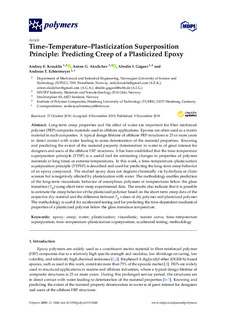| dc.contributor.author | Krauklis, Andrey | |
| dc.contributor.author | Akulichev, Anton | |
| dc.contributor.author | Gagani, Abedin | |
| dc.contributor.author | Echtermeyer, Andreas | |
| dc.date.accessioned | 2020-01-30T12:59:14Z | |
| dc.date.available | 2020-01-30T12:59:14Z | |
| dc.date.created | 2020-01-16T12:32:59Z | |
| dc.date.issued | 2019 | |
| dc.identifier.citation | Polymers. 2019, 11 (11), 1848-?. | nb_NO |
| dc.identifier.issn | 2073-4360 | |
| dc.identifier.uri | http://hdl.handle.net/11250/2638899 | |
| dc.description.abstract | Long-term creep properties and the effect of water are important for fiber reinforced polymer (FRP) composite materials used in offshore applications. Epoxies are often used as a matrix material in such composites. A typical design lifetime of offshore FRP structures is 25 or more years in direct contact with water leading to some deterioration of the material properties. Knowing and predicting the extent of the material property deterioration in water is of great interest for designers and users of the offshore FRP structures. It has been established that the time–temperature superposition principle (TTSP) is a useful tool for estimating changes in properties of polymer materials at long times or extreme temperatures. In this work, a time–temperature–plasticization superposition principle (TTPSP) is described and used for predicting the long-term creep behavior of an epoxy compound. The studied epoxy does not degrade chemically via hydrolysis or chain scission but is negatively affected by plasticization with water. The methodology enables prediction of the long-term viscoelastic behavior of amorphous polymers at temperatures below the glass transition (Tg) using short-term creep experimental data. The results also indicate that it is possible to estimate the creep behavior of the plasticized polymer based on the short-term creep data of the respective dry material and the difference between Tg values of dry polymer and plasticized polymer. The methodology is useful for accelerated testing and for predicting the time-dependent mechanical properties of a plasticized polymer below the glass transition temperature. | nb_NO |
| dc.language.iso | eng | nb_NO |
| dc.publisher | MDPI | nb_NO |
| dc.rights | Navngivelse 4.0 Internasjonal | * |
| dc.rights.uri | http://creativecommons.org/licenses/by/4.0/deed.no | * |
| dc.title | Time-Temperature-Plasticization Superposition Principle: Predicting Creep of a Plasticized Epoxy | nb_NO |
| dc.type | Journal article | nb_NO |
| dc.type | Peer reviewed | nb_NO |
| dc.description.version | publishedVersion | nb_NO |
| dc.source.pagenumber | 1848-? | nb_NO |
| dc.source.volume | 11 | nb_NO |
| dc.source.journal | Polymers | nb_NO |
| dc.source.issue | 11 | nb_NO |
| dc.identifier.doi | 10.3390/polym11111848 | |
| dc.identifier.cristin | 1774740 | |
| dc.description.localcode | © 2019 by the authors. Licensee MDPI, Basel, Switzerland. This article is an open access article distributed under the terms and conditions of the Creative Commons Attribution (CC BY) license (http://creativecommons.org/licenses/by/4.0/). | nb_NO |
| cristin.unitcode | 194,64,92,0 | |
| cristin.unitname | Institutt for maskinteknikk og produksjon | |
| cristin.ispublished | true | |
| cristin.fulltext | original | |
| cristin.qualitycode | 1 | |

